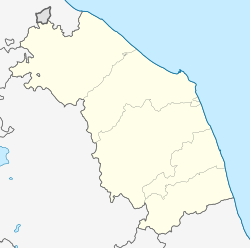Jesi
Comune di {{{name}}} | |
|---|---|
| Coordinates: 43°31′N 13°14′E / 43.517°N 13.233°E | |
| Country | Italy |
| Region | Marche |
| Province | Ancona (AN) |
| Frazioni | Mazzangrugno, Castelrosino, Tabano, Santa Lucia, Pantiere di Jesi |
| Government | |
| • Mayor | Fabiano Belcecchi (since May 28, 2002) |
| Area | |
| • Total | 108.9 km2 (42.0 sq mi) |
| Population | |
| • Total | 40,210 |
| Demonym | Jesini |
| Time zone | UTC+1 (CET) |
| • Summer (DST) | UTC+2 (CEST) |
| Postal code | 60035 |
| Dialing code | 0731 |
| Patron saint | San Settimio |
| Saint day | September 22 |
| Website | www.comune.jesi.an.it |
Jesi is a town and comune of the province of Ancona in the Marche, Italy.
This thriving and elegant centre is one of the most beguiling towns in this stretch of the Marche and boasts a sophisticated old centre and lively cultural life that should not be missed.
Its most striking feature greets you as you arrive - a belt of massive 14thC walls (above), built on Roman foundations, strengthened with buttresses and impregnable towers, and topped by houses. The main streets of the walled historic centre run along a narrow ridge and there is much to tempt you to explore.
History
This section needs expansion. You can help by adding to it. |
Now a quiet agricultural and commercial center in the floodplain on the left (north) bank of the Esino river 17 km before its mouth on the Adriatic, Jesi has a prominent place in history. It was annexed from the Umbrians by the Romans in 247BC. They called it "Aesis".Jesi is also the birthplace of the Holy Roman Emperor, Federico II, on 26 December 1194. His mother, Constance, was the sister of Emperor Federico I "Barbarossa" of the Staufen line who controlled Germany and Sicily. A rivalry between the Papacy and the Holy Roman Empire came to a head under the rule of the brilliant medieval German Hohenstaufen Emperor, Frederick II(Frederico II), the man who earned the title Stupor Mundi for his dazzling talents. Although he almost succeeded in creating a united Italy under his banner, his death in 1250 marked the eclipse of German imperial power in Italy. The Marche and Jesi, like the rest of central Italy, was deeply bound up in this conflict, with loyalties tied either to the Guelph or Ghibelline parties. The supporters of the papacy took their name from Frederick's rival for the empire, the Welf Otto, while the imperialists became known as Ghibellines from the Italianized Hohenstaufen battle-cry "Hie Weibling". Behind the simple struggle between the two powers lay a deeper political battle between the new middle class of merchants and artisans, who allied themselves with the Guelphs, and the old feudal aristocracy who saw that the tide of democracy could best be held in check by the Emperor's Ghibelline faction. Into this fundamental struggle all the warring factions of central Italy poured their energies. The Guelph cause can be said to have triumphed with the arrival of the French under Charles of Anjou in the middle of the 13thC at the invitation of Pope Urban IV; from now on France rather than Germany was to be the dominant foreign power in Italy. The absence of the papacy in Avignon from 1305-77, the subsequent Great Schism which saw up to three candidates claiming the Throne of St Peter, and the arrival of the Black Death in 1348, all provided fertile soil for the flowering of local despotism across the Marche. The careers of these petty tyrants were briefly interrupted by the arrival of the ruthless Cardinal Albornoz, sent by the Avignon popes to reimpose their rule over the Papal States, and finally went into decline with the restoration of the papacy in Rome in 1421 under the determined Pope Martin V. Jesi remained a papal territory until the risorgimento. To this day, the old Jesi within its high ancient walls and ramparts reminds one of another time.
Main sights
This section needs expansion. You can help by adding to it. |
The city's civic art gallery is home to a series of paintings by the Venetian artist Lorenzo Lotto.
Natives of Jesi
External links
- ^ "Superficie di Comuni Province e Regioni italiane al 9 ottobre 2011". Italian National Institute of Statistics. Retrieved 16 March 2019.
- ^ "Popolazione Residente al 1° Gennaio 2018". Italian National Institute of Statistics. Retrieved 16 March 2019.



